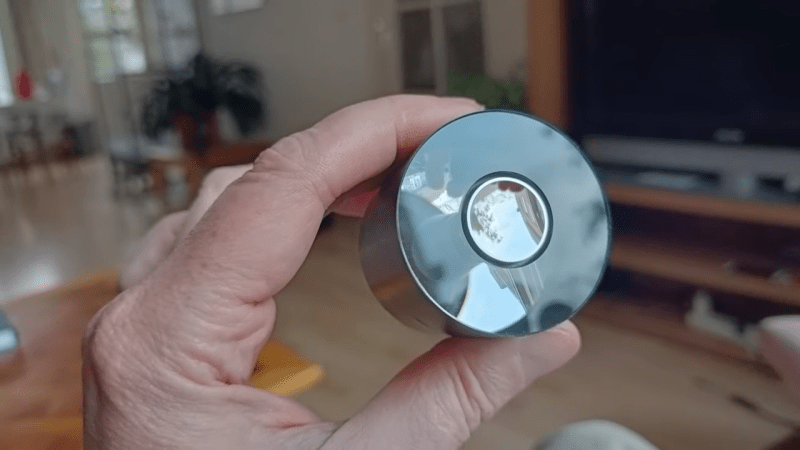If this is the easy part of making a complete reflector telescope from a single piece of glass, we can’t wait to get a load of the hard part!
A little backstory may be in order for those who don’t follow [Jeroen Vleggaar]’s Huygens Optics channel on YouTube. A few months ago, he released a video discussing monolithic telescopes, where all the reflective and refractive surfaces are ground into a single thick block of glass. Fellow optical engineer [Rik ter Horst] had built a few tiny monolithic Schmidt-Cassegrain reflectors for use in cube sats, so [Jeroen] decided to build a scaled-up version himself.
The build starts with a 45 mm thick block of crown glass, from which a 50 mm cylinder is bored with a diamond hole saw. The faces of the blank are then ground into complex curves to reflect incoming light, first off the parabolic rear surface and then onto the hyperbolic secondary mirror ground into the center of the front face. A final passage through a refracting surface in the center of the rear face completes the photons’ journey through the block of glass, squeezing a 275 mm focal length into a compact package.
All this, of course, vastly understates the work required to pull it off. Between the calculations needed to figure out the surface shapes in the first place to the steps taken to machine a famously unforgiving material like glass, every step is fraught with peril. And because the design is monolithic, any mistakes mean starting all over again. Check out the video below and marvel at the skills needed to get results like this.
What strikes us most about [Jeroen]’s videos is the mix of high-tech and age-old methods and materials used in making optics, which we’ve seen him put to use to make everything from tiny Tesla valves to variable-surface mirrors.
















Wow. He has all that in his basement? :O
Pump up the Ultra Phreotronic (Minute: 14:50) ! :D
Best presentation of spherometer I have seen on my entire life. Must be the fumes from PVD.
Really cool!
Warning!!! Don’t watch this video unless you can afford a several hour detour watching all his others. Great stuff!!!
I’d already found this channel, but its nice to know there are other nutters here that find this fascinating.
Could something like this be accomplished using clear resin?
I would say sort of, as I can’t see why you couldn’t, but resin are likely to have internal defects or mechanical stresses that will make it sub optimal as an optical device.
And if you don’t want to do all the polishing and finishing steps but just cast a ready made optic when the precision required is so high that is going to be a very large number of iterations to get the shrink induced distortions controlled – get a superb 2 part resin surface finish isn’t all that hard but it will shrink and warp as it sets and when you are talking nano meter and smaller feature precision required.
Borosilicate glass or very similar to pyrex
There is a complete article on this in the May 2022 Sky and Telescope magazine.
Rarely am I in awe of a fabrication process, maybe that’s an arrogance on my part, but just… wow. It’s truly amazing that it can be done like this with these levels of accuracy. I watched the all of the videos to this point – incredible stuff.
Always wanted to try making a pair of binocular glasses like this with a light path that goes back and forth about 20 times to the middle, for longer focal length in short package, but of course it’s a leeeeetle on the complex side to implement.
even more so when you reduce it to contact lenses: https://www.extremetech.com/extreme/160052-worlds-first-telescopic-contact-lens-gives-you-superman-like-vision
And just think, you never need to collimated. In fact you can’t. Except between telescope and sensor, that is.
Reckon these will be mass-produced at some point. In various sizes. These small ones are for use in Sat-cubes, btw.
I used to make optics for long path gas cells and am very familiar with the process. Good stuff